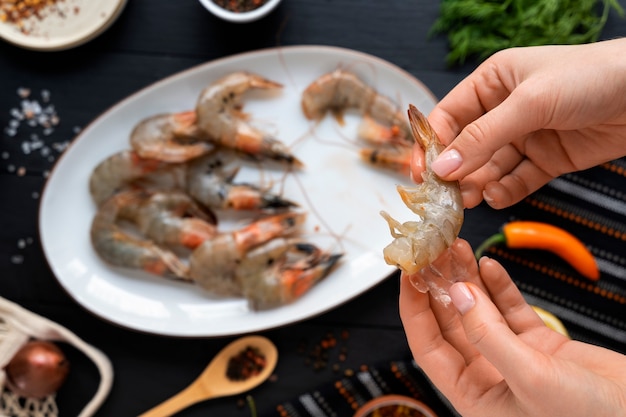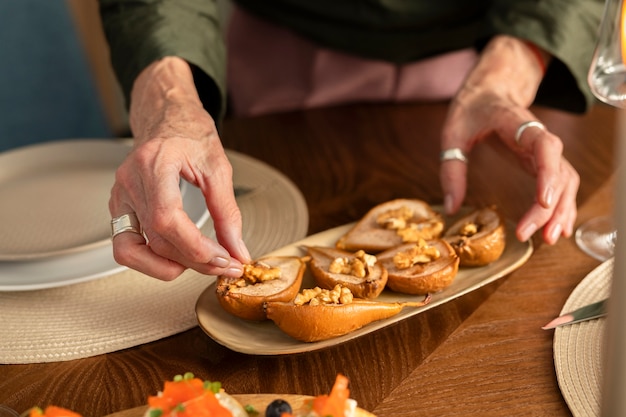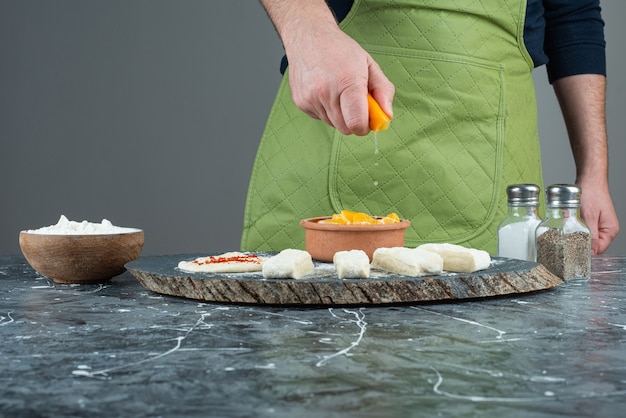Okay, let's talk scallops! I know what you might be thinking: "Those are fancy, restaurant-only things, right?" But you'd be surprised. You can absolutely nail this at home, and the payoff is truly impressive. Trust me, even if you're not a seasoned chef, you can get those stunning golden-brown crusts and juicy, tender insides. I've been there, done that, and I'm here to share the secrets I've learned along the way.
Honestly, scallops used to intimidate me. I thought they were too delicate, too fussy, and I was convinced I'd end up with rubbery, overcooked disasters. Then, one day, I decided to face my fears, and I'm so glad I did! It turns out, mastering scallops is easier than you think. It's all about a few key techniques, good quality ingredients, and a little confidence in the kitchen.
So, grab a glass of something refreshing, get comfortable, and let's dive into the world of perfect pan-seared scallops! This is going to be a fun ride.
(Part 1) The Scallop Lowdown: Understanding the Basics

Choosing Your Scallops: Freshness is Key!
Let's start with the star of the show – the scallops themselves! Now, I'm all for a good supermarket trip, but when it comes to scallops, I recommend going for the freshest option you can find. If you've got a fishmonger nearby, head straight there. These guys know their stuff and can give you the best advice on what's in season and what's freshest. Plus, you get to have a little chat about scallops, which is always a bonus!
What should you look for? First, plumpness is your friend. A scallop should feel firm and slightly springy, not mushy or limp. Next, check out the colour. They should be pearly white, with a slight hint of orange or pink. The darker the colour, the older the scallop. Lastly, give them a sniff. fresh scallops have a sweet, slightly briny aroma, not fishy or ammonia-like. If you pick up anything that smells off, give those scallops a miss.
Types of Scallops: Diver Scallops vs bay scallops
There are two main types of scallops you'll encounter: diver scallops and bay scallops. Diver scallops are larger, usually about 1.5 to 2 inches in diameter, and have a more pronounced "muscle" with a skirt. They have a richer, more intense flavour and are often considered the premium option. Bay scallops, on the other hand, are smaller and more delicate, with a sweeter flavour. They're often sold in clusters, and they can be a bit trickier to sear evenly because they're so small. If you're just starting out, stick with diver scallops - they're more forgiving and provide a great introduction to pan-searing.
The Importance of Drying
This is where a lot of people go wrong! You might think scallops are ready to go straight from the fridge to the pan, but that's not the case. You need to dry them thoroughly, and I mean really thoroughly. Why? wet scallops will steam instead of sear, resulting in a soggy, flavourless mess. So, pat them dry with paper towels, making sure to get rid of any excess moisture. I like to spread them out on a wire rack for a few minutes to make sure they're completely dry.
A Quick Note About Seasoning
Now, you might be thinking scallops need a heavy-handed approach to seasoning. Not so! They're delicate, and you want to enhance their natural flavour, not overpower it. A simple sprinkle of salt and pepper is all you need. If you're feeling fancy, a squeeze of lemon juice or a drizzle of olive oil can add a nice touch.
(Part 2) Mastering the perfect sear: Techniques for Success

The Right Pan for the Job: Cast Iron Is Your Best Friend!
Let's talk about pans. When it comes to pan-searing scallops, cast iron is your go-to. It distributes heat evenly and retains it beautifully, creating that perfect crispy crust. Plus, it's a real workhorse in the kitchen – perfect for searing, baking, and even frying. If you haven't got a cast iron pan yet, I highly recommend adding one to your collection. You won't regret it!
But if you're using a different pan, make sure it's heavy-bottomed and can handle high heat. A thin pan will warp and won't distribute heat evenly, leading to uneven cooking.
Heating Up: Getting the Pan Sizzling Hot
This is crucial! The pan needs to be screaming hot before you add the scallops. I'm talking a drop of water evaporating instantly hot. Why? Because a super-hot pan creates that beautiful golden-brown crust without overcooking the inside. Think of it like a kiss of fire, sealing in the juices and giving the scallops a flavour explosion.
The Art of Adding Scallops: Avoiding Overcrowding
Here's another common mistake: overcrowding the pan. Don't try to cram all your scallops in at once. You want to give them space to sear properly. If you overcrowd the pan, the scallops will steam instead of sear, and you'll end up with a soggy mess. So, work in batches, allowing enough space between each scallop for even cooking.
Keep the Pan Moving: Avoid Sticking
Once your scallops are in the pan, don't just leave them there and walk away! You need to keep them moving. This ensures even cooking and prevents them from sticking to the pan. A little swirl every now and then is all it takes to keep things moving along nicely.
Don't Touch Too Early: Let the Crust Form
Patience is key here! It's tempting to flip those scallops the second you put them in the pan, but resist the urge. You need to give them time to develop a crispy crust. A good rule of thumb is to leave them undisturbed for about 2-3 minutes per side. You'll know they're ready when they're golden brown and easily release from the pan.
Flip with Confidence: The Gentle Touch
Once the bottom side is beautifully browned, it's time to flip. Don't be afraid to do it with confidence. A gentle flip with a spatula is all you need. The top side will cook much faster, so keep a close eye on it. I'm usually talking about a minute or so for a perfect sear.
Rest for a Moment: Letting the Juices Settle
Before you dive in, give those scallops a little rest. Let them sit on a plate for a minute or two. This allows the juices to redistribute, ensuring the scallops stay moist and tender. I know, it's hard to wait, but trust me, it's worth it!
(Part 3) flavor combinations: Elevate Your Scallops

Simple and Delicious: Lemon and Butter
Let's start with a classic. Lemon and butter are a match made in heaven for scallops. The acidity of the lemon cuts through the richness of the butter, creating a refreshing and flavourful sauce. Just squeeze a little lemon juice over your seared scallops, add a knob of butter, and watch it melt into a silky sauce.
For a little extra zing, try adding a pinch of fresh herbs like dill or parsley. It adds a lovely brightness to the dish.
Spice Things Up: Garlic and Chilli
For a bit of a kick, add some garlic and chilli to your scallops. Sauté some chopped garlic and chilli flakes in a little olive oil until fragrant, then add your seared scallops. The garlic and chilli infuse the scallops with a delicious flavour, and the heat adds a nice little punch.
You can adjust the level of spice to your preference. If you like things extra fiery, try using a hotter chilli variety, or add a pinch of red pepper flakes.
Aromatic Delights: Herbs and Spices
Herbs and spices are a great way to add depth of flavour to your scallops. Try using fresh herbs like thyme, rosemary, or parsley, or add some ground spices like paprika, cumin, or coriander. You can even try a sprinkle of smoked paprika for an extra layer of smoky flavour.
Experiment with different combinations to find your favourites. A sprinkle of oregano and a squeeze of lemon juice is another classic pairing.
The Power of Wine: A Simple White Wine Sauce
White wine is a great addition to pan-seared scallops. It adds a touch of acidity and a subtle sweetness, creating a lovely sauce. Simply deglaze the pan with a splash of white wine after you remove the scallops, scraping up the delicious browned bits on the bottom. Let it simmer for a few minutes until it reduces to a sauce, then add a knob of butter to thicken it.
To make the sauce even richer, try using a slightly fruity white wine like Sauvignon Blanc or Pinot Grigio.
(Part 4) Serving Scallops: Making Them Shine
A Feast for the Eyes: Presentation is Key
Let's talk about presentation. Scallops are beautiful, so let them shine! Don't just pile them onto a plate and call it a day. Think about the visual appeal. Arrange them artfully on a plate, maybe with a sprig of parsley or a few lemon wedges for colour. You can even add a drizzle of sauce for an extra touch of elegance.
Accompaniments for Delight: side dishes to Compliment
Scallops are versatile and pair well with a variety of side dishes. Here are a few ideas to get you started:
- Creamy Risotto: The richness of risotto is a perfect complement to the delicate sweetness of scallops. For an extra touch of flavour, try incorporating some fresh herbs or lemon zest into the risotto.
- Roasted Vegetables: Asparagus, broccoli, or Brussels sprouts roasted with a little olive oil and salt and pepper are simple and delicious. Adding a sprinkle of herbs like thyme or rosemary during roasting adds another layer of flavour.
- potato gratin: A classic potato gratin adds a creamy and comforting element to the dish. To elevate the gratin, try using a combination of cheeses like Gruyere, Fontina, and Parmesan for a richer flavour profile.
- Simple Salad: A light and refreshing salad with mixed greens, cherry tomatoes, and a vinaigrette dressing is a great counterpoint to the rich scallops. A sprinkle of toasted walnuts or pecans adds a lovely crunch and nutty flavour.
- Polenta: Creamy polenta provides a comforting base for the scallops. You can even incorporate herbs or cheese into the polenta for a more flavourful experience.
(Part 5) The Perfect Plate: Building Your Scallop Dish
The Scallop Symphony: Balancing Flavours and Textures
Now, let's talk about building the perfect scallop dish. It's all about creating a harmonious balance of flavours and textures. Think about the interplay between the scallops, the side dish, and the sauce. You want to create a dish that's exciting and satisfying, not just a jumble of ingredients.
Examples of Delicious Combinations: Inspiration for Your Plate
Here are a few examples of flavour and texture combinations that work well with pan-seared scallops:
| Dish | Side Dish | Sauce |
|---|---|---|
| Pan-Seared Scallops | Creamy Risotto with Parmesan Cheese | Lemon-Butter Sauce with Fresh Dill |
| Pan-Seared Scallops with Garlic and Chilli | roasted asparagus with Lemon and Herbs | White Wine Sauce with a Pinch of Red Pepper Flakes |
| Pan-Seared Scallops with Smoked Paprika | Potato Gratin with Gruyere Cheese | Brown Butter Sauce with a Splash of Sherry Vinegar |
| Pan-Seared Scallops with Herbs | Simple Salad with Vinaigrette Dressing | Lemon-Herb Sauce with a Drizzle of Olive Oil |
| Pan-Seared Scallops with Lemon and Thyme | Creamy Polenta with Parmesan Cheese | Brown Butter Sauce with a Squeeze of Lemon Juice |
Feel free to experiment and find your own favourite combinations. The beauty of cooking is that you can get creative and personalize your dishes to your liking.
(Part 6) Beyond the Pan: Other Ways to Cook Scallops
Pan-searing is the most common way to cook scallops, but there are other methods you can explore. Here are a few ideas to expand your culinary repertoire:
grilled scallops: Smoky Flavours
The smoky flavour of grilled scallops is truly delicious. Simply preheat your grill to medium-high heat, then grill the scallops for 2-3 minutes per side, or until they are cooked through. Serve them with a simple lemon-herb sauce, or try a more adventurous flavour combination like chimichurri or a mango salsa.
For extra flavour, you can brush the scallops with a marinade before grilling. A simple mixture of olive oil, lemon juice, and fresh herbs is a great option.
baked scallops: Tender and Delicious
Baking scallops in the oven creates a wonderfully tender texture. Simply toss them with some olive oil, salt and pepper, and your favourite herbs and spices, then bake them in a preheated oven at 400°F (200°C) for 8-10 minutes, or until they are cooked through. This method is perfect for a crowd, as you can bake a large batch at once.
To add a touch of luxury, try wrapping the scallops in bacon before baking. The bacon adds a smoky, salty flavour and helps to keep the scallops moist.
Seared and Finished in the Oven: The Best of Both Worlds
For the ultimate in crispy crust and tender interior, you can sear the scallops in a pan, then finish them in the oven. This method ensures that the scallops get a nice sear on the outside while still remaining moist and tender on the inside. Simply sear the scallops in a pan for 2-3 minutes per side, then transfer them to a preheated oven at 400°F (200°C) for 5-7 minutes, or until they are cooked through.
This technique is particularly useful if you're cooking a large number of scallops, as it allows you to sear them in batches without overcrowding the pan.
(Part 7) FAQs: The Answers You Need
Now, let's tackle some common questions about scallops:
1. How Do I Know If Scallops Are Done?
You'll know your scallops are done when the center is opaque and no longer translucent. They should have a nice, firm texture and be easily pierced with a fork. Don't overcook them or they will become tough.
2. Can I Use frozen scallops?
Yes, you can use frozen scallops. Just make sure to thaw them thoroughly in the refrigerator before cooking. Once thawed, pat them dry with paper towels and proceed as you would with fresh scallops.
Frozen scallops will usually be slightly smaller than fresh ones, so you might need to adjust your cooking time accordingly.
3. What Happens if I Overcook Scallops?
Overcooked scallops will be tough and rubbery, and the delicious flavour will be lost. Keep a close eye on them and remove them from the heat as soon as they are cooked through.
If you're unsure about how long to cook your scallops, it's better to err on the side of undercooking. You can always cook them for a little longer if needed, but you can't undo overcooking.
4. How Long Can I Store Fresh Scallops?
Fresh scallops should be stored in the refrigerator and used within 1-2 days. If you're not planning to use them right away, you can freeze them for up to 3 months.
When freezing scallops, it's best to freeze them individually to prevent them from sticking together. You can wrap them in plastic wrap or aluminum foil, or store them in freezer-safe bags.
5. Can I Reheat Scallops?
While not ideal, you can reheat scallops. The best way is to do it gently in a skillet over low heat with a little butter or olive oil. This will help to keep them moist and prevent them from drying out.
Avoid reheating scallops in the microwave, as this will make them rubbery.
(Part 8) The Final Word: Embrace the Scallop Journey
So, there you have it! A comprehensive guide to perfect pan-seared scallops. Remember, practice makes perfect, and don't be afraid to experiment. Try different flavour combinations, side dishes, and cooking methods. The world of scallops is your oyster, so dive in and enjoy the culinary adventure!
Everyone is watching

How to Cook Frozen Lobster Tails Perfectly: A Step-by-Step Guide
RecipesLobster. Just the word conjures up images of lavish meals, special occasions, and a taste of luxury. But let's...

Pigs in a Blanket Cooking Time: How Long to Bake for Perfect Results
RecipesAh, pigs in a blanket. Just the name conjures up images of those delightful little parcels of crispy pastry en...

Pork Fillet Cooking Time: How Long to Cook It Perfectly
RecipesPork fillet, or tenderloin as it's sometimes called, is a real favourite in our house. It's so versatile, and...

The Ultimate Guide to Tender, Juicy Pulled Pork
RecipesRight, let's talk pulled pork. It's one of those dishes that just screams "comfort food," doesn't it? I mean...

The Ultimate Guide to Cooking Sweet Potatoes: From Roasting to Mashing
RecipesSweet potatoes. Just the name conjures up images of warm, comforting dishes, bursts of vibrant color, and a to...
